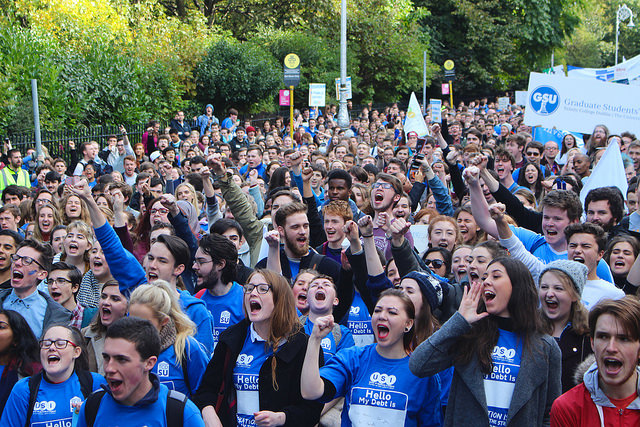With decisions looming on the future of higher education funding, students will take to the streets once again on October 4th, as the Union of Students in Ireland (USI) today announced proposed plans for their national demonstration.
The date for the demonstration, which is due to be voted on at a meeting of USI’s national council tomorrow, is significant, coming before Budget 2018 is announced. Last year, thousands of students marched calling for publicly funded education, alongside university staff and trade unions. A working group of students’ union presidents have already agreed in principle to support the date for the demonstration.
The proposal for the demonstration, authored by Amy Kelly, the Vice-President for Campaigns in USI, states that the demonstration will “not be labelled as a student protest”, but will instead highlight “the consensus and support for publicly-funded education”. This has been a regular trend in recent years with the union avoiding associations with student protests, pitching the march instead as an expression of support for publicly funded education.
The march has largely become a regular fixture of the student calendar and, despite an increased focus on lobbying in recent years by USI, is still seen as a significant part of the union’s campaign against loan schemes.
Last year, the march took place after the government’s Budget announcement of marginally increased funding for the sector. This year, however, the march will be pitched as an opportunity for students to get their voices heard before Budget 2018. This year’s march could prove the most important yet for the national union – while the union has focused on lobbying politicians in last few months and promoting their own pre-budget submission, the march is an opportunity to show the groundswell of support for publicly funded education as the government prepares to make a decision on a new funding model for the beleaguered sector.
Universities and students have often been at cross-purposes when it comes to a new funding model. However, the march last year was marked by a dramatic show of solidarity from various colleges, with Trinity’s Vice-Provost Chris Morash addressing hundreds of students in Front Square.
The announcement follows the voting down of a Labour motion in the Seanad calling on the government to reject loan schemes. The defeat of this motion in July was seen as a blow to student activists, who had strongly supported it.
With 2018 still the target for when a new funding model could be implemented, the march will be a crucial show of support for an issue that has for years been on the periphery of the government’s agenda. Michael Kerrigan, President of the USI, said in an interview with The University Times in March, that “a lot more than 12,000 students on the street” will be needed if a loan scheme is threatened by the government.
Speaking to The University Times, Trinity College Dublin Students’ Union President Kevin Keane said the demonstration would be a “pivotal day in the history and future of the student movement”. Praising the “stellar work” done by student activists in the past, he said: “We cannot stand by as the government look to cripple our generation with unjust, unfair and ill-considered loans.”
The annual march has seen varying turnouts and approaches. The “Education not Emigration” demonstration in 2010 saw up to 40,000 people take to the streets up Dublin. Although numbers declined in following years, the demonstrations still continued as a fixture in the student calendar. In 2013’s “Fight For Your Future Now”, Dublin was removed as the focus and several smaller regional demonstrations were held instead.
The following year saw a new approach taken by USI, returning to a Dublin-centric event. Six thousand protesters took part in the rally for the “Education Is” campaign, intended as a “celebration” of education.
After the replacement of the traditional pre-budget protest with a national voter registration day in 2015, last year’s demonstration saw a 10,000 strong crowd marched through Dublin to Merrion Square.







